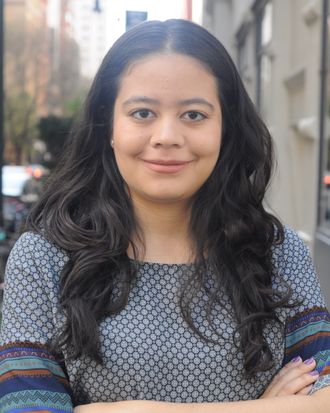
The team of journalists at New York works hard to bring you conversation-starting stories. But who exactly are these editors and writers? Get to know them with a New York Minute, our interview series in which we ask staff about their lives and their careers. Next up: Curbed city reporter Valeria Ricciulli.
Curbed is now part of New York Magazine! What excites you most about this transition?
What excites me the most about the transition is to be able to cover the topics New Yorkers care about the most right now in greater depth and rigor (housing, homelessness, renter’s market, tenants’ rights) and with the obsessiveness, expertise, and critical eye on the built environment and design that Curbed is known for.
You’ve spent the past two years covering New York City real estate, housing, transportation, and development for Curbed. How did you get started as a city reporter?
I got started as an intern at El Diario, the largest Spanish-language newspaper in the NYC area, covering a wide variety of topics for both their print and online version. After eight months there, I worked as a breaking-news reporter (or runner) at the now-defunct DNAinfo.com, where I basically ran around the city reporting on fires, crime, and other topics.
What are the driving questions that guide your work?
I think the main questions I ask myself are: What do New Yorkers need to know right now?, and How would this help them in their day-to-day? Learning to make things readable, approachable, and usable for everyone is something that motivates me every day, and writing pieces that are both informative and service-y is something that I’ve learned and honed while at Curbed (and I have my editors to thank for that!). I also try to put compassion first, and perhaps get our audience to learn or care about someone (or something) they would have otherwise ignored.
How do you switch gears between covering beautiful (and often expensive) listings for sale and more in-depth reporting, like on homelessness in NYC? What does that mix of topics offer you, and how do you come up with story ideas?
I think I began to reconcile the two by exploring the ways in which everything is connected (for instance, how the large amount of expensive listings in the market, and the lack of affordable options, are interconnected to the city’s housing/homelessness crisis) and how both things are part of the city’s reality. And on the listings side, it also helped to learn about the architecture behind homes in historic districts, for instance, which is fascinating. I love the mix because I’m able to balance lighter and hard news on any given day.
You’re originally from Colombia. How does your background influence the topics you cover, if at all?
I think being from Colombia, and Latinx, allows me to bring issues that my fellow Hispanic immigrants face to the conversation and, for instance, to highlight some of the contributions of Hispanics and Latinxs (and immigrants in general) to NYC and the country. It also helps to speak Spanish and being able to include voices of non-English speakers in what I write.
As a multilingual reporter who has written in English, Spanish, and Portuguese, how do you think English-language publications can be more inclusive?
I believe hiring reporters who can speak different languages (and communicate with people who do) is key, as they can give a platform to voices that are otherwise unheard in English publications. But, perhaps most importantly, aside from hiring them, it’s vital to create internal processes and policies that allow these writers (and their ideas!) to thrive inside newsrooms.
What’s one recent story you’re especially proud of and why?
I’m really proud of this story about Casa Amadeo, a Bronx record store that has been open for over half a century and has survived many things, including the pandemic. I loved that I got to meet Mike Amadeo, the store’s 86-year-old owner, who’s truly a character. We talked for hours, and he told me about his life back in Puerto Rico, where he’s from, how he got into the music business in NYC, and how he’s written songs for virtually every famous salsa-music star (including Héctor Lavoe, El Gran Combo de Puerto Rico, Celia Cruz, etc.). It’s just amazing and fascinating to talk to someone who knows so much, has been in this city for so long, and has that passion, grit, and character that New Yorkers are known for.
There’s been a lot of talk about the future of cities, with New York City at the forefront of the conversation. How do you respond to people who believe New York, as it was before the pandemic, is “over”?
I think it is a very misguided and elitist notion: Dead for whom? Anyone who’s actually spent time in New York City over the last months, in any of the five boroughs, will know that the city is alive and well. And there are many examples of this all around: streeteries, outdoor improvised performances, neighbors organizing to help each other, community fridges — the list goes on. Obviously, I’d say that doesn’t mean everything’s perfect. A lot of long-existing issues have been exacerbated due to the economic effects of the pandemic; there’s a looming eviction crisis, record unemployment, a struggling MTA, and New Yorkers who have recently become homeless. Those are definitely things that need our attention.
How can readers support or get involved with your reporting?
Please send tips to valeria.ricciulli@curbed.com or to my Twitter page. My DMs are open!
You can follow Valeria on Twitter.
Subscribe to New York
For less than $5/month, you’ll get unlimited digital access to New York, home of Intelligencer, Vulture, the Cut, Grub Street, and the Strategist.